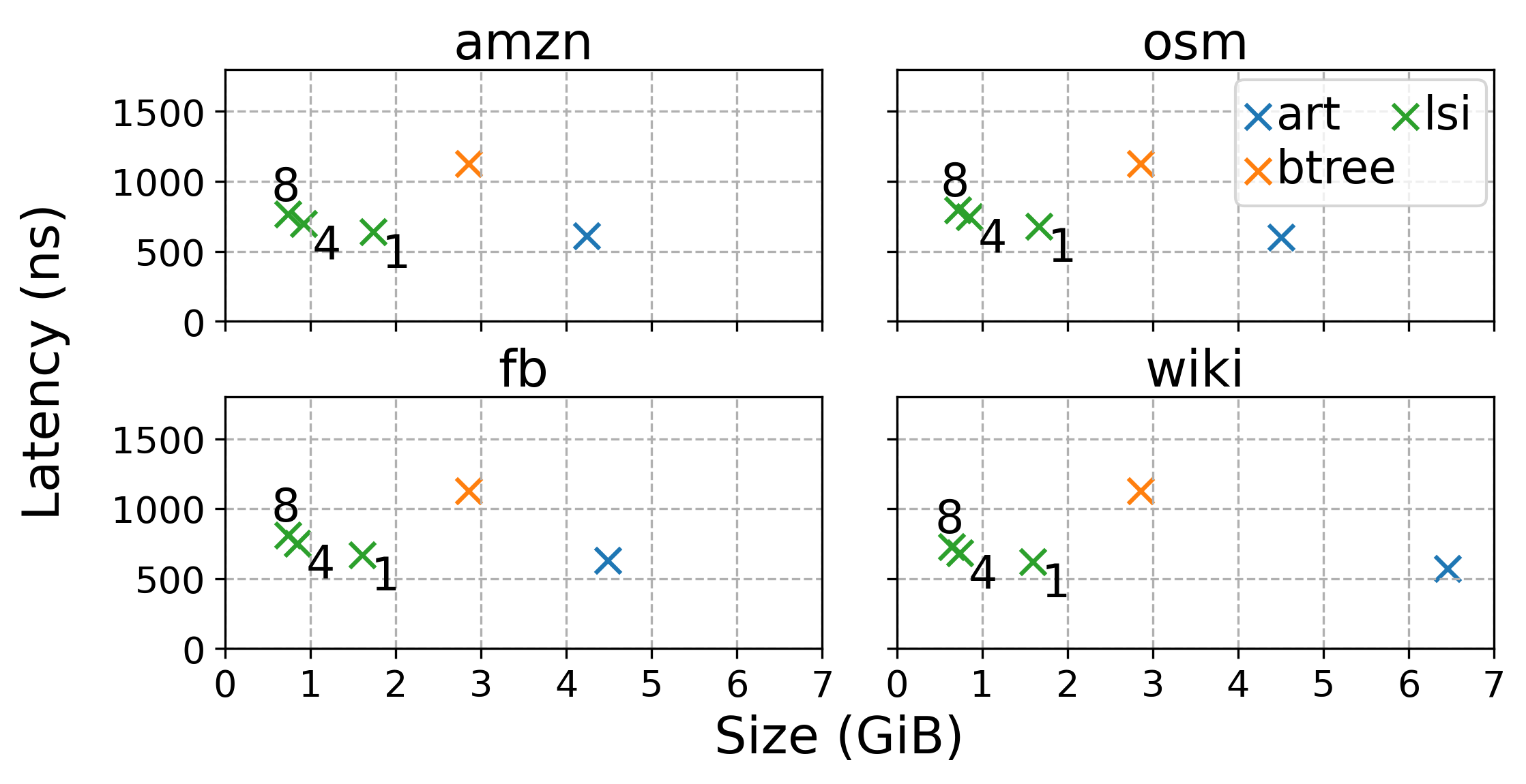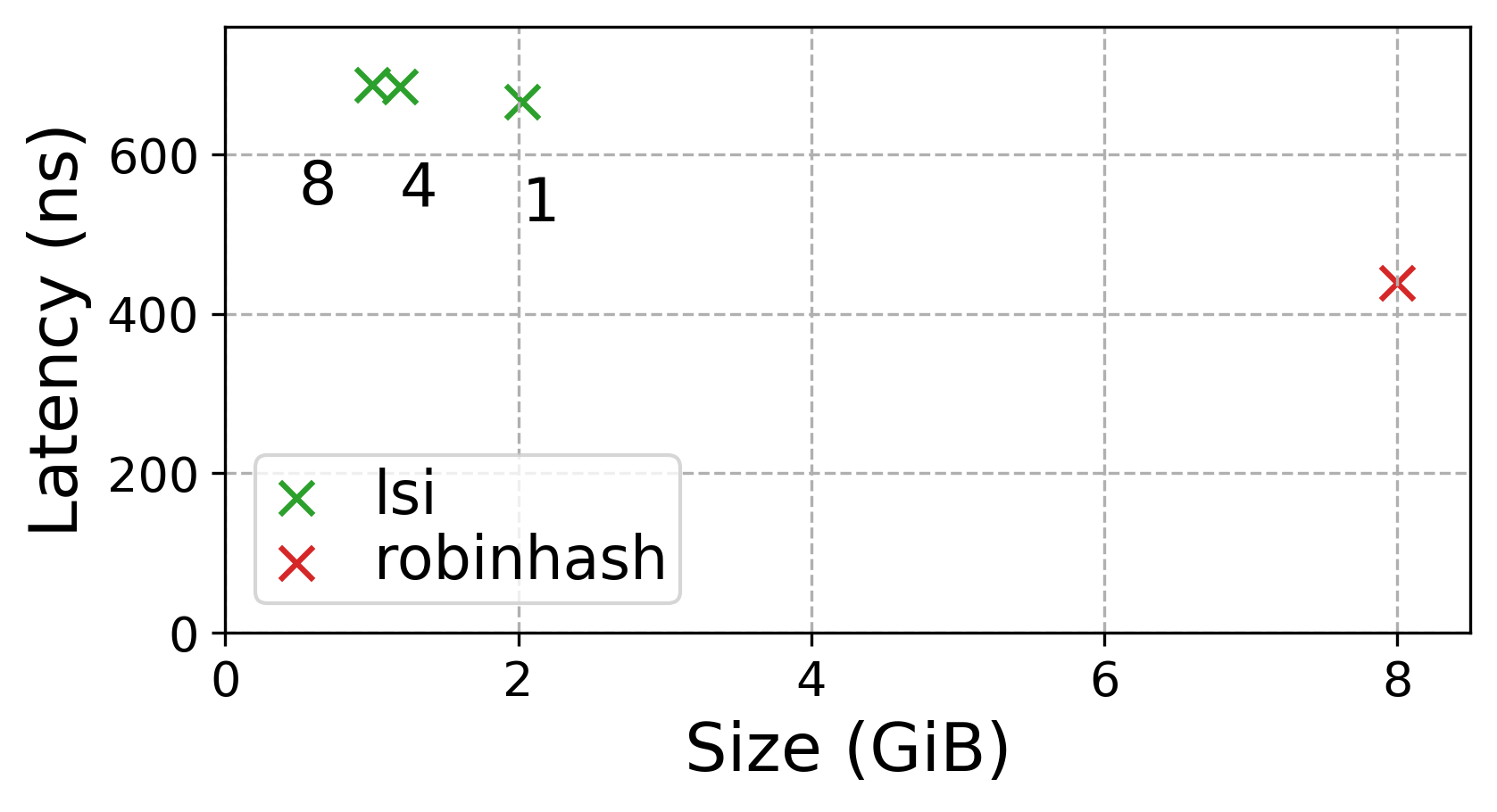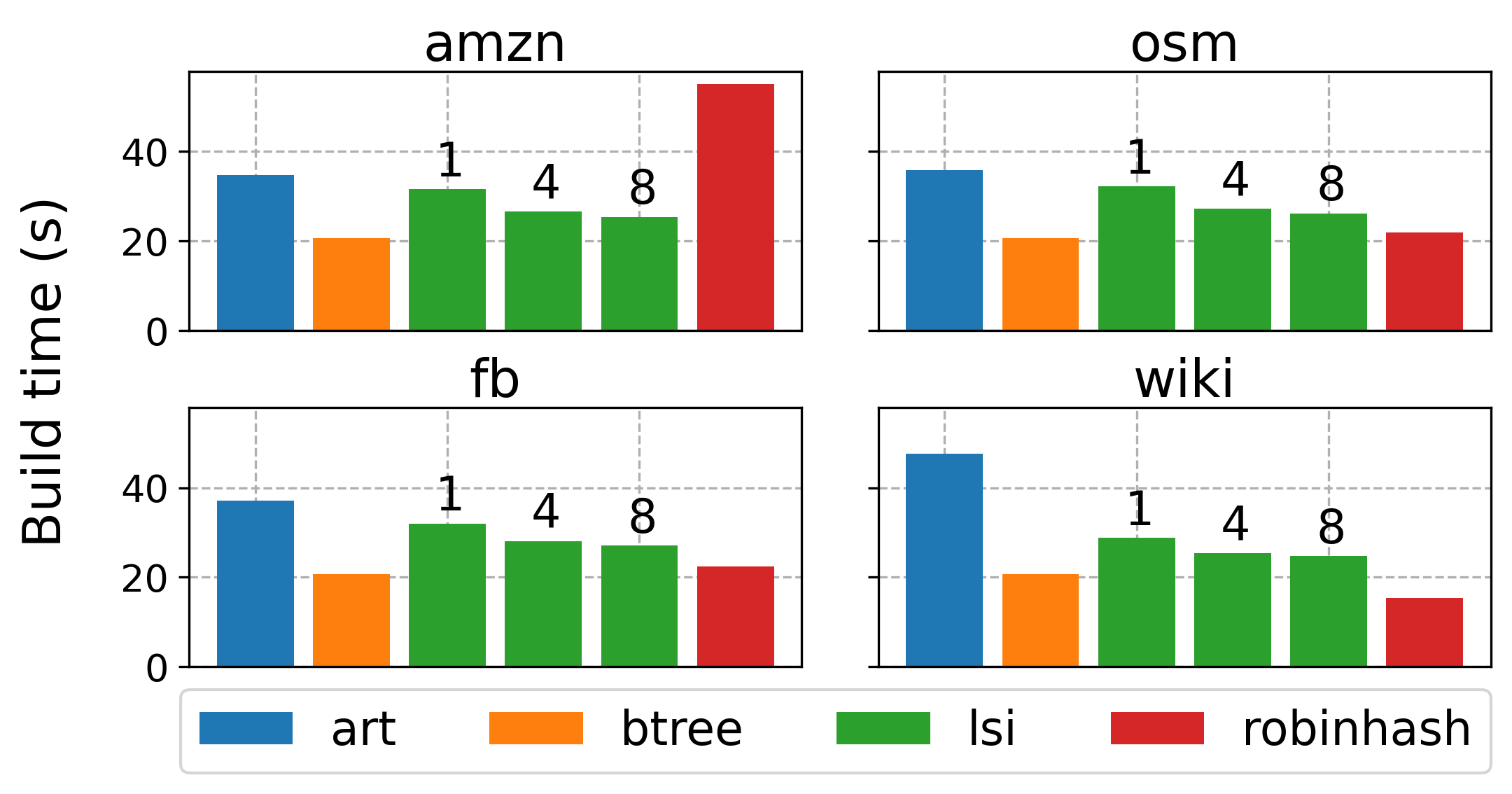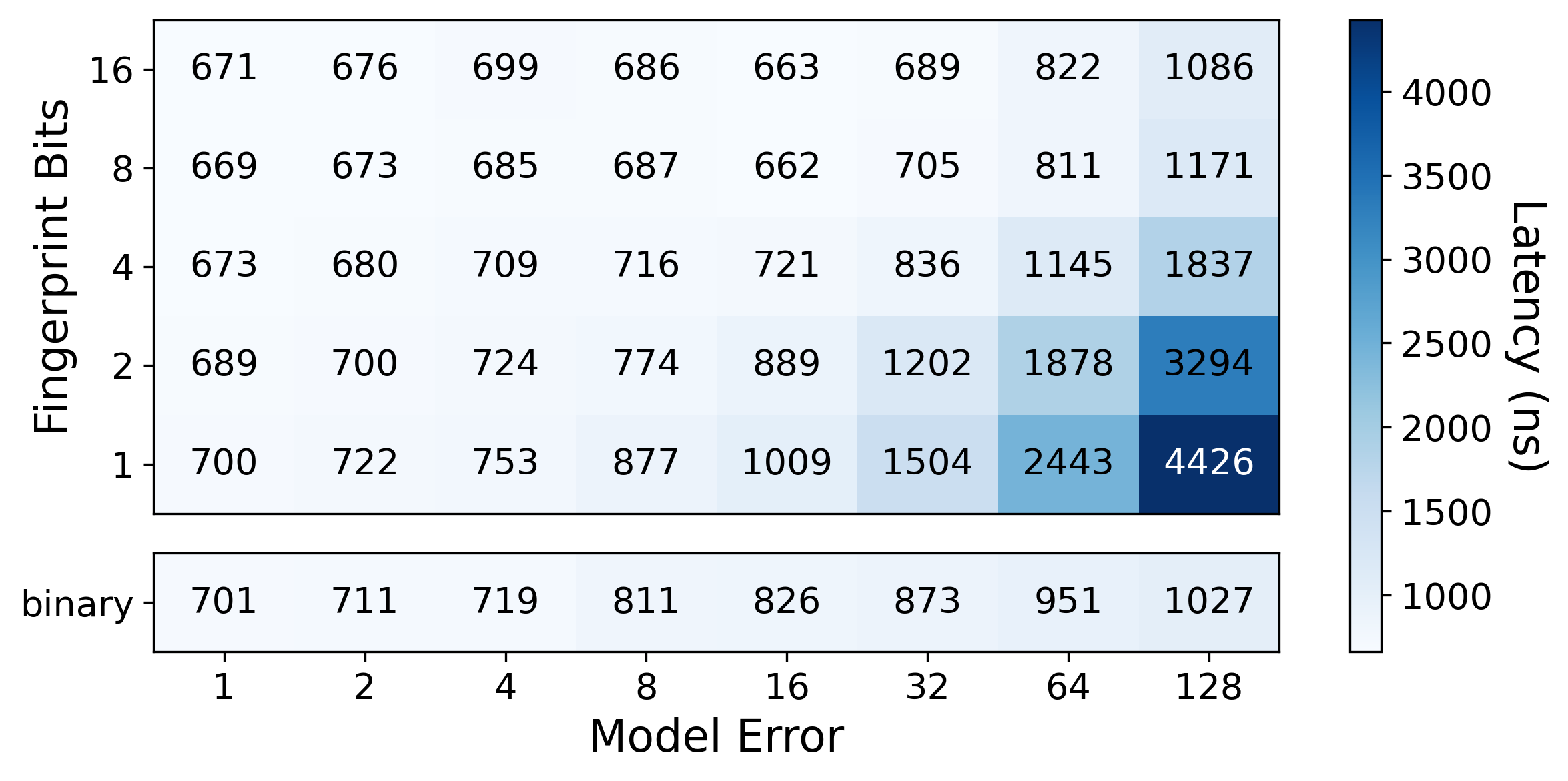Authors: Dominik Horn,
Andreas Kipf,
Pascal Pfeil
We are happy to present LSI: A Learned Secondary Index
Structure and our accompanying
open-source C++
implementation that
can easily be included in other projects using CMake
FetchContent.
LSI is a learned secondary index. It offers competitive lookup performance on
real-world datasets while reducing space usage by up to 6x compared to
state-of-the-art secondary index structures.
Motivation
Most learned index
structures focus on
primary indexing where base data is stored in sorted order. Since a table can
only be sorted by a single key, it is therefore of high interest to study the
feasibility of applying learned techniques to indexing unsorted, secondary
columns. Specifically, we were aiming to come up with an off-the-shelf usable
index structure that manages to retain the proven benefits of learned primary
indexes as best
as possible.
LSI Overview
LSI consists of two parts. A pre-existing learned index structure acting as an
approximate index, e.g., a PLEX, and a
permutation vector. The learned index is trained over a temporary sorted copy
of the base data’s keys. The permutation vector retains a mapping from the
sorted key’s positions to offsets (tuple IDs) into the base data. The following
paragraph contains a schematic illustration of LSI. A more detailed
explanation, especially concerning how we achieved LSI’s space efficiency, can
be found in our paper.
Lookups
Querying LSI works in three steps, as illustrated below:

- Query the learned index for an approximate position in the sorted base data.
Again, note that the sorted representation is not actually stored and only
exists temporarily during construction.
- Obtain search bounds based on the approximate position and the learned
index’s error bounds. These can either be guaranteed by construction, as is
the case with PLEX, or could be measured
and retained during training.
- Conduct a local search over the permutation vector to locate the key.
- Lower-Bound Lookups perform a binary search. Note that this requires
O(log k) probes into the base data for a search interval of size k. This
could potentially be prohibitively costly in practice, e.g., when base
data is not fully loaded into main memory.
- Equality Lookups can be sped up by retaining fingerprint bits for each
key and performing a linear scan over the search interval. This requires
O(k) base data probes for a search interval of size k. However, each
additional fingerprint bit roughly halves the number of required accesses.
Evaluation
Evaluations were conducted on a c5.9xlarge AWS machine with 36 vCPUs and 72 GiB
of RAM using four real-world datasets from
SOSD, each with 200 million 64-bit unsigned
integer keys:
amzn book popularity datafb randomly sampled Facebook user IDsosm cell IDs from Open Street Mapwiki timestamps of edits from Wikipedia
All experiments ran single threaded. To prevent skew from potential
out-of-order execution, we insert a full memory fence using the compiler’s
built in __sync_synchronize() after each lookup. A more detailed writeup of
our findings can be found in our paper.
Lower-Bound Lookups
To benchmark lower-bound lookups, we randomly remove 10% of the
elements from the datasets before building each index. We only query for
non-keys.
LSI with PLEX as its approximate index is
competitive with ART’s latency,
while consuming up to 6x less space. It is twice as fast as
BTree while reducing space consumption
by up to 3x.

Note that BTree was constructed by first sorting the data and bulk loading it
afterwards. This enables denser nodes and therefore faster lookups. Inserting
keys in random order one after another increased space usage by roughly 33% and
slowed down lookups by more than 20%. The text annotations denote the LSI
model’s error bound.
Equality Lookups
Although LSI with PLEX as its approximate
index is around 1.5x slower than the robin-hood hash table implementation
RobinMap, it consumes less than a
quarter of the space. The text annotations again denote the LSI model’s error
bound. Note that we used the amzn dataset for this test, only to later
discover that RobinMap’s hash function appears to be unfavorably biased in
this case. On fb and osm, RobinMap’s lookup only takes 340ns compared to
the 440ns on amzn. Space consumption does not change.

Build Time
We measured the true end-to-end build time for each index given an unsorted
continuous in-memory representation of each dataset’s 200 million keys. LSI is
competitive in terms of build time. It performs slightly worse than BTree, but
surpasses ART on every dataset we
tested. As expected, tighter error bounds on the approximate index increase build
time.
BTree is constructed by first sorting
and the bulk loading all keys. This is about 8x faster than inserting keys
in unsorted order one by one. ART does not have a bulk-loading interface,
however, its construction time is still cut in half when keys are first sorted
and then inserted one after another. We suspect this effect is primarily caused
by better cache behavior during construction.

Note that we would have expected
RobinMap to exhibit equal build
throughput on amzn, fb and osm. Further investigation is required to
determine why it performs so poorly on amzn. We suspect that the hash function,
which we have no control over, might be unfavorably biased in this case. More
than half of all elements from wiki are duplicates. For this reason, build
times for RobinMap on this dataset appear faster.
Fingerprint Configuration
We conducted a micro experiment to study the trade off between binary search
and linear search with fingerprints. For this purpose, we trained LSI with
PLEX as an approximate index on amzn
using various errors and fingerprint bit sizes (denoted in brackets), and
compared lookup latencies:


For a search bound of size k, binary search always performs O(log k) probes
into the base data, while linear search requires O(k). Each additional
fingerprint bit will roughly halve the number of base data accesses.
Future Work
We are excited about our promising first results of approaching secondary
indexing using learned techniques. For production readiness, we will need to
add support for inserts. This will require two main adjustments. First, the
approximate index has to be updateable. We could either attempt to extend
PLEX with support for inserts, or use an
existing off-the-shelf model that supports inserts like
PGM. Additionally, we
will have to find a better way to deal with dynamic updates to the permutation
vector. As implemented currently, each update will require shifting and
incrementing values, or O(n) time.
Another interesting direction is to try and reduce base data accesses during
lower-bound lookups. While we could just store a copy of all keys in the
permutation vector, similar to BTree’s leaf layer, this will negate most of
LSI’s space savings. However, there might be an opportunity to store just
enough information to reconstruct enough information about the keys to enable
efficient (binary) searching. Stay tuned!